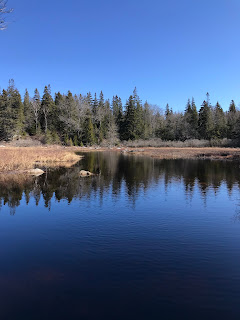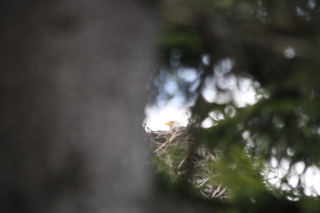 |
| spotted salamander egg mass photo by Banner Moffat |
Welcome to the Vinalhaven Sightings Report – April 19, 2020
Brought to you with the support of VLT and MCHT –
Thanks to both organizations!
 |
| mack's pond |
Highlights – River otter videos!, Spotted Salamander stuff, Northern Harrier, half a shrew, red-backed salamander, Hermit Thrush, and so much more!
 |
| seal bay |
Tiit Trick –
click on photos to enlarge! And Enjoy!!!!!
PSA – Hey – What
a spring, huh? While many of us have been practicing “social distancing” for
decades, there are many behavior adjustments one can make to decrease the
chances of being exposed to or exposing others. The town has been posting daily
Covid-19 updates and information on the town’s website –

For exercise of the mind and body many
folks are hitting the trails both on island and on the mainland. Be aware that
certain points on preserves - picnic tables, benches, kiosks – are points of
contact for hikers and follow social distancing practices on the trails. And
while it’s highly unlikely anything would come of hiking on the preserves, washing
hands after hiking – that sounds so funny – is a good idea.
 |
| skunk cabbage so robust these days! |
Sightings – Erin
Creelman was kind enough to share these videos and photo she took of a
recent River Otter visit to the small
pond right by her house! Erin mentioned the lack of frogs calling from the pond
this year, and this may be the reason!
If you have a pond with water in it
in mid-coast Maine, river otters know of it and visit it. On this particular
visit the otter was macking on Spotted
Salamanders! As Erin put it – they don’t like the tails!
Erin’s proximity to the Basin, Long Pond, Mill River and Folly Pond–
all well established/documented River otter zones – puts her pond right in the “Otter Triangle”, aka “Otter Polygon” and makes the likelihood
of an otter visit that much greater.
 |
| gang of woodcocks photo by John Drury |
Awesomely incredible footage Erin! Thanks for sharing!
(4/19) This just in – just above Old Harbor Pond – John Drury spotted a family
of Woodcocks crossing the road! Yep, it’s that time of the year again – “Drive Slowly, Baby Woodcocks are out!” –
classic PSA.
 |
| the big one is the leader photo by John Drury |
Anyway, the adults have been back for a month and a half, and looks like they didn’t wait around to get going on the next generation! Cool to see and a cool reminder that even while many birds that breed locally aren’t even close to being here yet (mid-april is peak songbird migration in coastal Georgia) there are many species around that start early. Great Horned Owls, Bald Eagles, Ravens and Crossbills have probably also been ‘at it’ for a bit as well! Cool to see!
Greens Island – More from John – John was kind enough to send in photos of a male Northern Harrier hunting the fields on Greens. Great sight and great shot!
Raptors are showing up, passing through and many are still on their way! Always
good to have an eye on the sky, as well as an eye on the pet guinea pig you are
walking! Don’t always see that many male Harriers – treat to get photo of one!
Huber – Pat Lundholm spotted a Pileated Woodpecker on a recent visit to the preserve. Pileated sightings have been on the rise for the last five to 7 years – they are big, they are loud, but they are not always that easy to spot. Always a treat to see one.
(4/15) Spent the day at Huber. Hermit thrush, Winter Wren, Brown Creeper, Dark-eyed Junco, Golden-crowned Kinglet, spotted salamander eggs with spermatophores nearby. Mourning Cloak Butterfly, Garter Snake, other stuff
The story here was with the spotted salamander egg masses and
spermatophores. Things were super fresh, and it looked like the timing matched
the vernal pools I have been watching on the mainland. A 2nd, more
robust round of Spermatophores were placed Monday night (4/13). Egg masses were
laid Tuesday night (4/14). And then Kirky got to see them Wednesday (4/15). The
trailside ditch pool only had one mass – it is a pool that fluctuates between
0-7 I would say. Maybe a third round this week?
 With time constraints I only ventured to off trail to one historic pool.
This particular pool is part of a treed wetland complex where an uprooted tree pulled
opened a pool in the mossiness that surrounds. I counted 46 masses in the photo
– give or take I would say – which is typical for this pool. In 2008 we came
across this well-established pool, and while the branch had probably changed
over time, it’s always wonderful to see a submerged limb covered in eggs. How many
salamanders have emerged from this pool over the years?
With time constraints I only ventured to off trail to one historic pool.
This particular pool is part of a treed wetland complex where an uprooted tree pulled
opened a pool in the mossiness that surrounds. I counted 46 masses in the photo
– give or take I would say – which is typical for this pool. In 2008 we came
across this well-established pool, and while the branch had probably changed
over time, it’s always wonderful to see a submerged limb covered in eggs. How many
salamanders have emerged from this pool over the years?
The flip side is that many salamanders don’t leave this pool – life can
be like that. While fish are not established in the pool system there,
caddisflies apparently had no problem overwintering in the muck. The activity
of the 9 or so present made the egg masses a lively spot. the caddisfly is the critter dragging along a protective casing they build around themselves
The outer matrix of the salamander eggs is to protect the eggs from
drying out if the pool goes low, and also acts as a deterrent to critters like
Caddiflies who like to feast on their eggs.
And apparently some get distractedby/feast on spermatophores. A lot of protein I guess?
this video was supposed to be horizontal.
this video was supposed to be horizontal.
The caddisflies may get a few eggs, fungus will get others, but many will
survive to hatch and swim around with gills as larvae. Good luck youngsters!
(4/17) Basin –
Great Blue Herons, Bald Eagle, Ravens,
Crows. Brown Creeper, Winter Wren, White-throated Sparrow, Golden-crowned
Kinglet, half a shrew, red-backed salamander.

Lots of activity, and the breeze kept
things moving in the air above. Red-backed salamander was cool.
One of the oddest things though was
finding half a shrew. It looked like a finger puppet when I found it. I am
guessing a cat was involved.
Anyway – here’s a poem I wrote about
it
‘1/2 a shrew’ or ‘the ½ that got away’ by Kirk Gentalen
Today I found ½ a shrew
This much of my story is true
The other ½ I did not see
Even though they might have been in front of me

My gut said that even with a search we would not find
The ½ of the shrew that includes its behind
That got me thinking, if I had to choose
Which ½ of a shrew would I use?
Im not sure whats the deal
But I kinda like the way this one feels
Like a finger puppet or toy,
A treasure for a girl or boy
So I prefer the top, yes
I guess

Good stuff out there! Here’s a few of Leif!
See you out there!






























